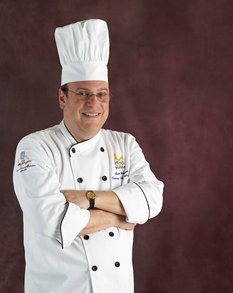50-Minute Classroom: Sauté
04 January 2012
 Your students will want to reach for the tongs, spatula or spoon. Don’t let them. These six steps in class will effectively remove students’ fear—and enhance their thrill—of sautéing.
Your students will want to reach for the tongs, spatula or spoon. Don’t let them. These six steps in class will effectively remove students’ fear—and enhance their thrill—of sautéing.
By Adam Weiner, CFSE
For the last several articles I have addressed teaching business skills of our industry and teaching techniques. Now it is time to return to the teaching of specific cooking subjects. A cooking technique that both thrills and terrifies students is sautéing. To alleviate the fear, minimize the mess and cut back on food costs try the following six steps:
1. Teach What Is Sautéing. Sautéing basically means “to jump” in French. Tell your students that the different ingredients are cut into uniform size, and are added to the pan in the order of what takes the longest to cook going in first. The food is jumped, not stirred. In other words, the cook keeps flipping the food over in the pan so all sides of the food cook uniformly. Usually sautéing is done with a small amount of fat (generally oil or butter) in the pan.
2. How Not to Teach the Sauté Technique. Traditionally, cooking instructors have shown their students the proper technique of tilting the sauté pan, moving the food toward the bottom of the pan, and then jerking the pan back in a manner that tosses the food back into the center of the pan. Then the students are left on their own. The result is a lot of food on the floor, students who are afraid of the flames coming off the burners, and a lot of improperly cooked food. Many students give up at this point and grab a spatula or a spoon.
3. Show Why Stirring Doesn’t Work. Before you show students the correct sauté technique, you must show them the necessity for flipping the food in the pan. To do this, get a stack of pennies. Have the students put a few pennies head side up in the pan and ask them to pretend—off the heat—they are sautéing the pennies for one minute. (Note: Don’t do this in Teflon or similar coated pans.) They will grab a tongs, spatula or spoon and start stirring the pennies. When they are done, point out that the pennies are still head side up! In other words, with their technique they never cooked the head side of the coin.
4. Show the Students How to Sauté the Pennies. Now show the students the proper sautéing technique. Let the students practice, but I suggest they practice away from the stove to avoid coins going down the burner openings. It will be a bit noisy with coins flying around the room, but pretty soon your students should get the hang of it.
5. Refine the Technique. Explain to your students that when they are sautéing, you add in different foods at different times because the different ingredients have different cooking times, but they all must be done at the same time. For example, garlic burns quickly, so it is added to a sauté pan of vegetables close to the end. The problem is getting all of the food evenly mixed together. To teach this I give each student or team of students several small containers—each one with a different dried legume (e.g., garbanzo beans, pinto beans and black beans) or dried peas. Away from the stove I have them add the garbanzo beans and pretend sauté for one minute, add the pinto beans and pretend sauté for one minute, etc. This way the students can see that their sautéing technique is “cooking” all of the items in the pan and that all of the different items are getting integrated together.
6. Practice Makes Perfect. I guarantee that when you ask your students to sauté the next day, they will reach for the tongs, spatula or spoon. Pull these away from them and make them practice, practice and practice.
Finally, make sure that your students know that the last step in sautéing is to clean up their mess on the floor. And, that is where the beauty of my method really shines: Coins and dried beans are a lot easier to clean than sautéed onions, garlic and pasta.
Chef Adam Weiner, CFSE, teaches a 20-week Introduction to Cooking program for JobTrain on the San Francisco Peninsula.
